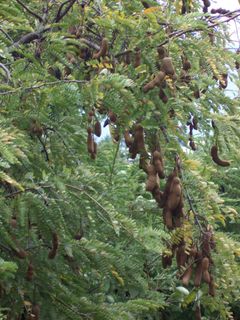Tamarind
2007 Schools Wikipedia Selection. Related subjects: Organisms
| iTamarind | ||||||||||||||||||
|---|---|---|---|---|---|---|---|---|---|---|---|---|---|---|---|---|---|---|
 |
||||||||||||||||||
| Scientific classification | ||||||||||||||||||
|
||||||||||||||||||
|
|
||||||||||||||||||
| Tamarindus indica L. |
The Tamarind (Tamarindus indica) is the only species of the genus Tamarindus in the family Fabaceae. It is a tropical tree, native to eastern Africa, including parts of the Madagascar dry deciduous forests. It grows wild throughout the Sudan but has now been introduced into most of tropical Asia as well as Latin America and the Caribbean.
The tree can grow up to 20 m in height, and stays evergreen in regions without a dry season. Tamarind timber consists of hard, dark red heartwood and softer, yellowish sapwood. The leaves consist of 10-40 leaflets. The flowers are produced in racemes. The fruit is a brown pod-like legume, which contains a soft pulp and many hard-coated seeds. The seeds can be scarified to enhance germination.
Alternative names include Indian date, translation of Arabic تمر هندي tamr hindī. In Malaysia it is called asam in Malay and swee boey in Hokkien. In Indonesia it is called asem (or asam) Jawa (means Javanese asam) in Indonesian. In India it is called imli. In Bangla, the term is tẽtul. In Sinhala the name is siyambala, in Telugu it is called Chintachettu (tree) and Chintapandu (fruit extract) and in Tamil and Malayalam it is puli. In Kannada it is called hunase. In Malagasy it is called voamadilo. The tamarind is the provincial tree of the Phetchabun province of Thailand (in Thailand it is called Ma-kham).
Uses
The fruit pulp is edible and popular. It is used as a spice in both Asian and Latin American cuisines, and is also an important ingredient in Worcestershire sauce and HP sauce. The pulp of a young fruit is very sour and acidic and is most often used as a component of savory dishes. The ripened fruit is sweeter and can be used in desserts and drinks, or as a snack.
In temples especially in Asian countries, the pulp is used to clean brass shrine furniture, removing dulling and the greenish patina that form .
The wood is a bold red colour. Due to its density and durability, tamarind heartwood can be used in making furniture and wood flooring. A tamarind switch is sometimes used as an implement for corporal punishment.
Tamarind trees are very common in South India, particularly in Tamil Nadu and Andhra Pradesh. They are used as ornamental trees and to provide shade on the country roads and highways. Monkeys love the ripened tamarind fruit.
The pulp, leaves, and bark also have medical applications. For example, in the Philippines, the leaves have been traditionally used in herbal tea for reducing malaria fever. Due to its medicinal value, tamarind is used as an Ayurvedic Medicine for gastric and/or digestion problems.
Tamarind is a staple in the South Indian diet, where it is used to prepare Kuzambu or Sambhar (spicy lentil soup vegetables and tamarind), a soupy preparation called pulikkuzambu popular in Tamil Nadu, Puliyodarai rice, and various types of chutneys. Tamarind is available in Indian stores worldwide. It is also sold as a candy in Mexico (see for example pulparindo), and in various snack forms in Southeast Asia (dried and salted, dried and candied, as a cold drink). Pad Thai, a dish popular in Thai restaurants in the U.S., uses tamarind as its dominant flavor.
It's very difficult to find tamarind sauce but it goes very well with lamb shanks.
In Latin America, especially Mexico, and Latin American immigrant communities in the US, the fruit is wildly popular and is fashioned into many kinds of treat. Many popular Tamarindo concoctions are hard candies and suckers and one of the most popular aguas frescas is flavored with tamarind. Tamarind is a popular food in Mexico and is used in many Mexican candies. Likewise Sino-Peruvian food uses tamarind-based juice for its distinctive sweet flavour. [ citations needed]
Metaphorical use
In Mexican slang (especially in Mexico City), the term tamarind also refers to traffic control officers, due to the colour of their uniforms.

